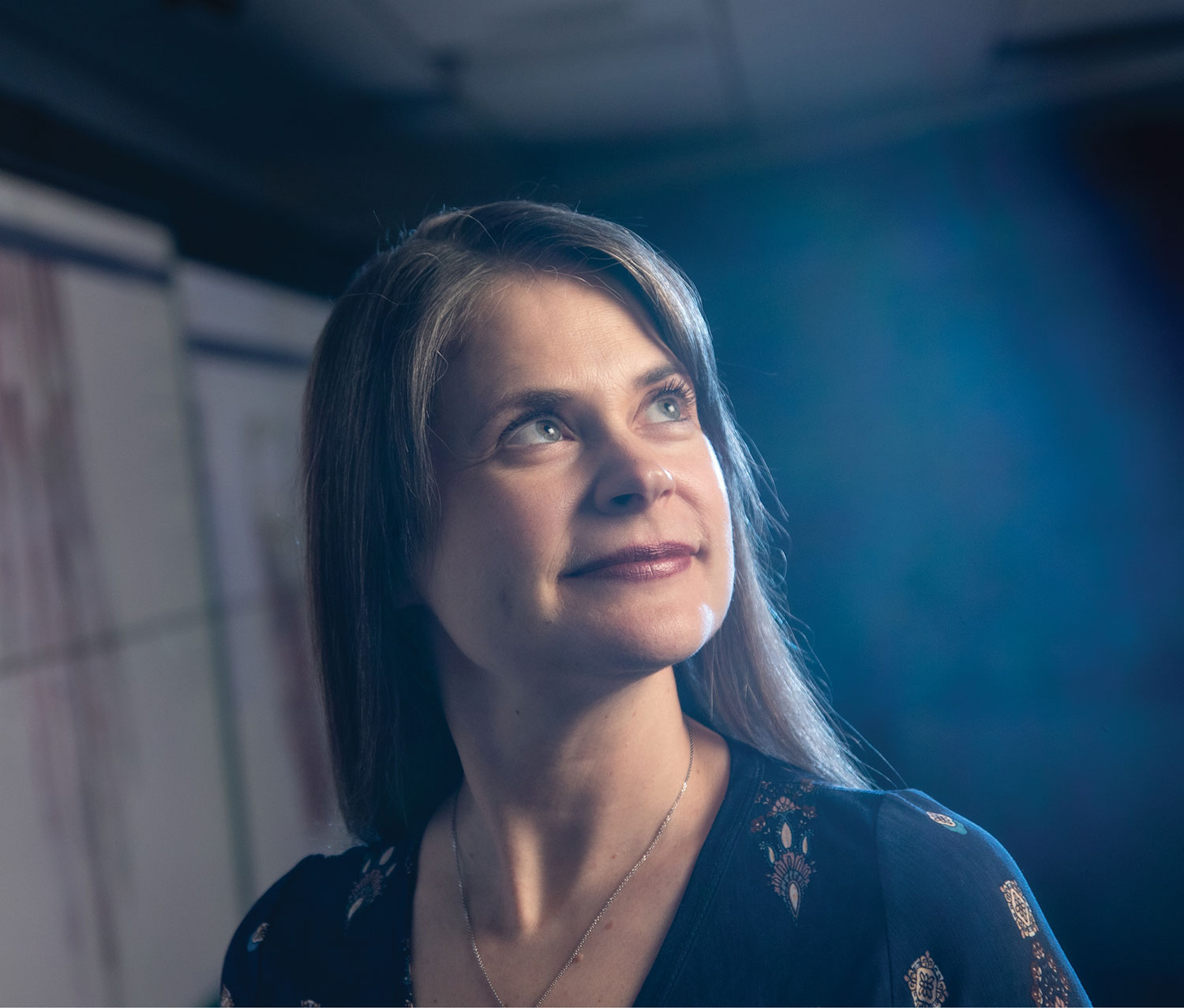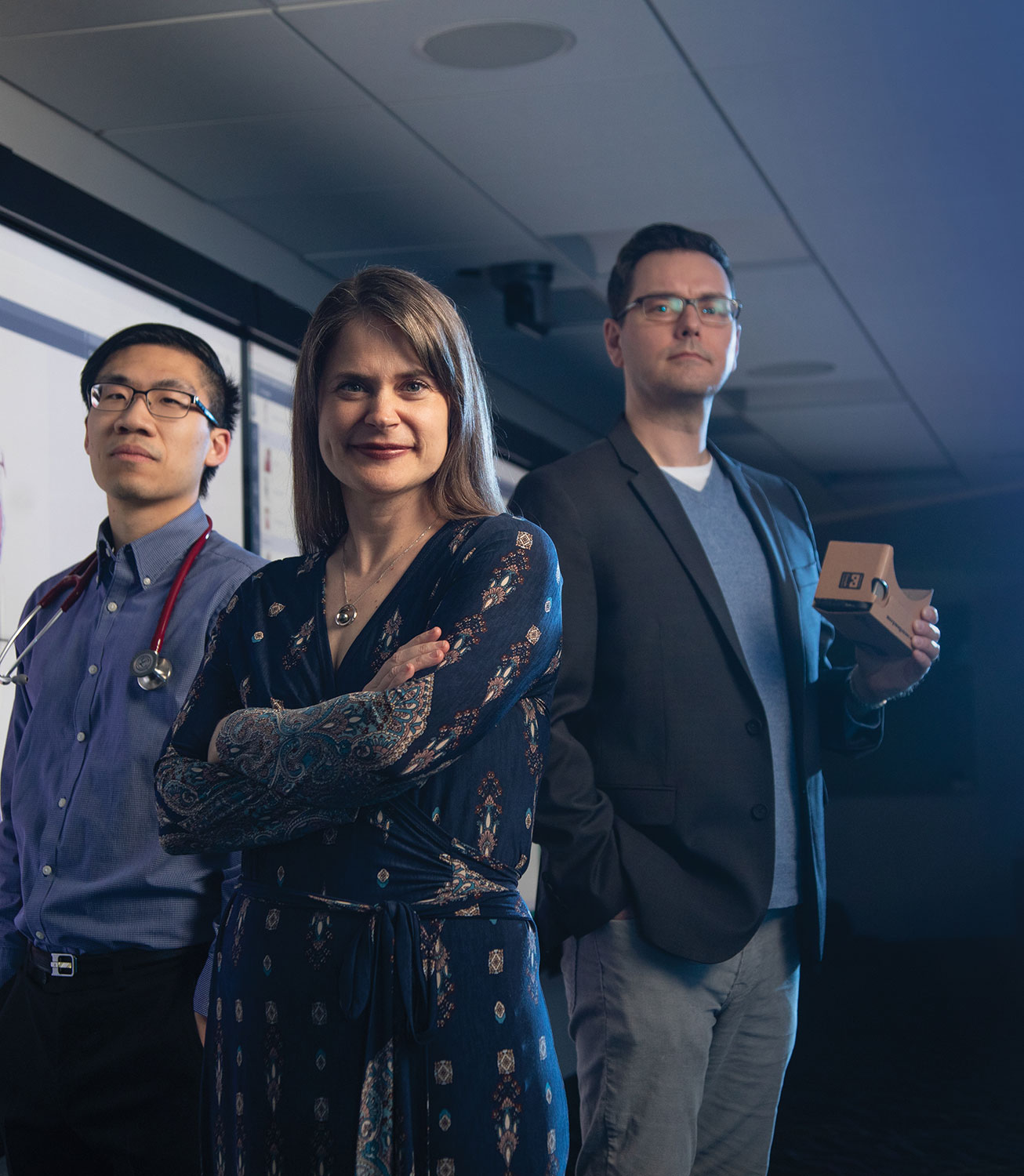When Lyn Sonnenberg, '14 MEd, MD, talks about new technology and medical school training, her eyes blaze with passion and possibility. The associate dean of Educational Innovation & Academic Technologies sees amazing potential in new technologies to help educate health professionals and, ultimately, improve patient outcomes.
"I want the University of Alberta to be a place where students don't see technology as an adjunct, but as an integrated experience," she says. "I want us as faculty to be comfortable with how we use technology, and students to feel like it just makes sense."
In the decade since the Academic Technologies office was created, an explosion of new technology with significant educational potential has come to campus. Forget iPads and SmartBoards; imagine being able to dissect a body in virtual reality, or having the location of a patient's internal organs holographically overlaid on their body. The opportunities are endless, with many possible on campus right now.
One of the challenges faced by Sonnenberg's team, however, is that new technologies are making their way into the day-to-day lives of health-care providers regardless of how prepared they are.
Industry is showing an interest in partnering with the faculty to help introduce future clinicians to technological advancements, says Sonnenberg. "We need to be better at introducing technology earlier in the learning process and integrating it into the curriculum."
In the classroom
Paul LaPointe, '97 BSc, PhD, says new technologies help students get up to speed in a world that is moving faster every day. It's what drove the associate professor of cell biology and co-creator of Cell 101 VR-a VR program that gives users the opportunity to see and experience the inner workings of cells in 3D-to start looking for ways to use augmented reality in his classroom.
"It's a bit of a cliché to say that information moves so fast, but there's definitely a widening gap between what is being taught in university and where people are when they come out of high school," says LaPointe, who recently joined Sonnenberg's team as the first director of Extended Reality (XR). He believes technologies such as augmented reality (AR) and VR with Google Cardboard can give students the opportunity to actually experience learning and gain fundamental understanding using their smart phones.
"There aren't many tools that can actually show you the mechanics of how a cell works as a three-dimensional object," LaPointe says. "But with virtual reality or augmented reality, you can see each piece, animate them and watch each piece work together. You get to experience how a cell works firsthand, and that is so much more effective for understanding a concept."

Paul LaPointe is the first-ever director of Extended Reality in the Faculty of Medicine and Dentistry's Office of Academic Technologies.
Photo: Laughing Dog Photography
Student input is key
As a fourth-year medical student and president of the Canadian Federation of Medical Students, Victor Do recognizes the value that technology can bring to medical education. He's quick to point out, however, that technology in and of itself does not make great health-care professionals.
"Technology can help push people to greater potential," he stresses, "but it's still up to the physician to be a good learner and use the technology in the right way.
"I think it's really important that physicians and medical learners are technology literate, because ultimately we're going to be the ones using that technology to treat patients," he adds. "We've seen several examples where large companies jump in and develop technologies for health care apart from physicians, which is very frustrating."
"We need to get involved in thinking about how technologies and health education can work together, because it's going to happen with or without us," he says. "But we need to know about what is available to us and what is possible before we can do that." Students want tools-technological or otherwise-that will help them be better physicians, he says, with the goal of better patient outcomes.
Luckily for students like him, that's exactly what Lyn Sonnenberg wants too.

Integrating technology early into the learning process for medical students is a passion project for Lyn Sonnenberg, who is a developmental pediatrician as well as associate dean of Educational Innovation & Academic Technologies.
Photo: Laughing Dog Photography
Spreading the word
Last year, Academic Technologies and the U of A Libraries held the first Digital Anatomy Showcase. Hosted in Cameron Library's futuristic Digital Scholarship Centre, the two-hour showcase featured presentations of three online anatomy educational resources-Anatomy.tv, Body Interact and VH Dissector-as well as a demonstration of a VR anatomy program designed by the U of A's Cognitive Projections, a collaboration between the faculties of Medicine & Dentistry and Rehabilitation Medicine.
Sonnenberg says the point of the showcase was to raise awareness about the range of technologies available to students and staff, and kick-start a larger conversation about how technology can be better integrated into medical education.
She recounts recently showing a neuroradiologist Anatomy.tv, an online program that provides 3D interactive models of human anatomy.
"I showed him how the program could display anatomy and radiology together, and he literally dropped his pen on the table and said, 'I'm throwing out my PowerPoint slides. I'm going to teach like this from now on!'"
Transforming teaching, transforming care
Sonnenberg, LaPointe and Do agree that integrating new technology and innovation in medical education is not about the technology itself; there will always be something new and exciting on the horizon.
"It's really about how we are teaching, and how we are breaking down challenging concepts for learners," Sonnenberg says. "If we can help them understand what they need to learn better, then they can translate that to the patients they're serving. I believe that if we transform the learner, we transform care."
"What VR, AR and other new technologies have in common is that they allow the students to experience something in ways you can't describe," LaPointe says. "I think the real revolutionary power of new technology is in the ability to make medical breakthroughs and other complex ideas easier to understand, which in turn helps close the gap between the frontiers of scientific discovery and the learner just getting interested in a field."
"I'm excited about any new technology that helps me do my job, as long as our foundation is that these are tools, and not a replacement for doing a physical exam or talking to the patient and getting to know them," Do says.
"If we get the foundational knowledge solidly in place, there are only good things that can build upon that," Sonnenberg agrees. "We have such a creative and innovative group at the University of Alberta, and I want to tap into that energy, immerse people in the tools we have and use that knowledge to change the world."
"This is just the beginning."
